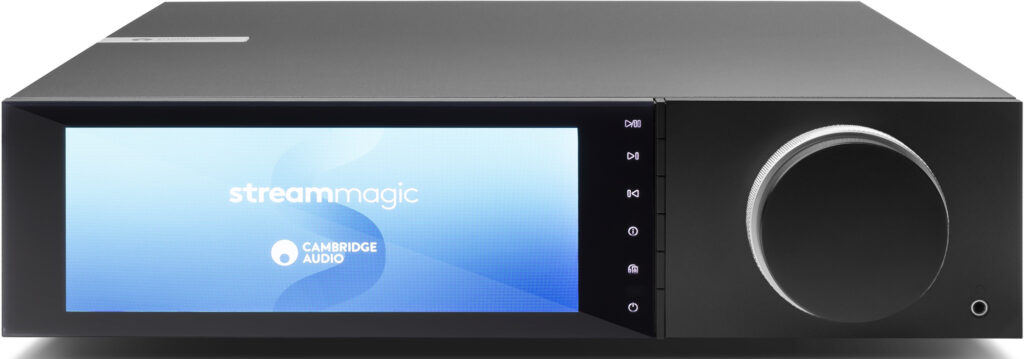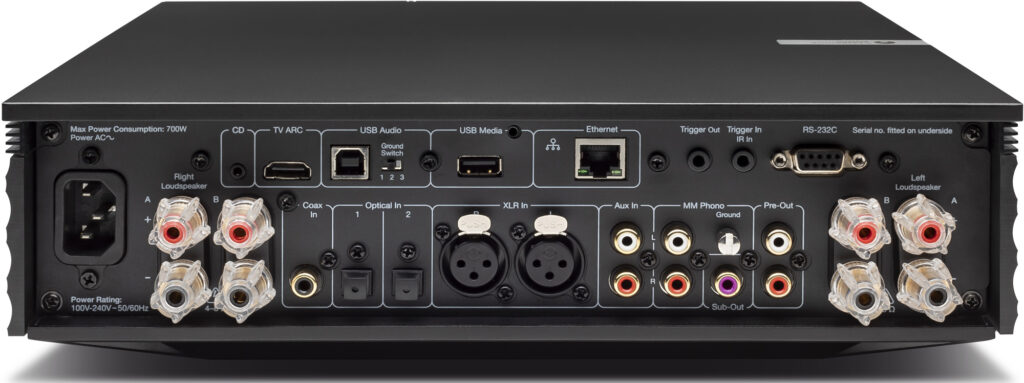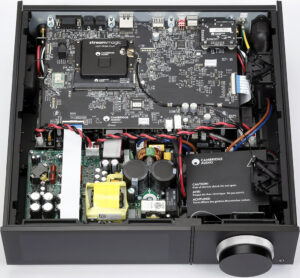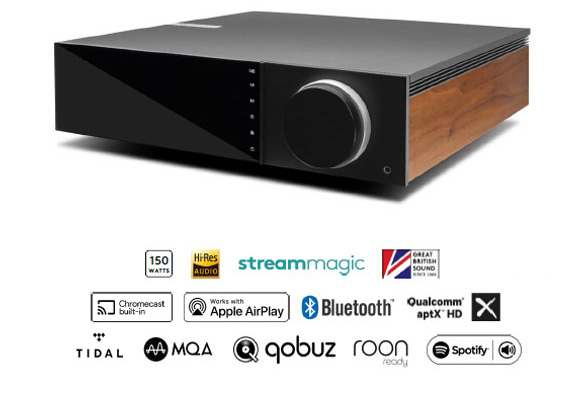The Cambridge Audio EVO 150 at first glance is a network streamer and integrated amplifier and, while that would not be factually incorrect, it is that much and more. Its industrial design, highlighted by the borderless display screen (picture a resort hotel’s rooftop infinite pool viewed from above), serves not only its effusive functionality and connectivity but delivers stunning visual appeal. The display, bright and lustrous, can be dimmed, but why? It displays not only album cover artwork but all the features and available connections at one’s disposal.
Streamlined, the unit measures 12-9/16” wide by 3-1/2” high by14-5/8” deep and weighs in at a not-too-hefty 11.68 lbs. This reviewer managed to tote the EVO 150 with one hand and ably carried it about his home from room to room hooking it up to various sets of speakers and systems. Readers shall remember that for some time before the pandemic, I was travelling the world with my trusty Bel Canto s300 integrated amp in tow as it auto-switched voltage, so I could take it pretty much anywhere on planes in my rolling bag. With the slightly larger dimensions of the EVO 150, I know I can still make this work, even if it means designing a custom case.
There’s no wanting for power. As the name suggests, the EVO 150 delivers 150 watts per channel (8 ohms), which it does via Hypex NCore modules. Yes, it’s class D, and yes some will scoff, and for those who do, keep in mind that there’s a Pre-Out option to connect the amplifier of one’s choice, and for that matter via the analog aux inputs or the balanced XLRs one can bypass the internal DAC and use one of their choosing. It is the flexibility I find so appealing. But why would I want to even bypass any part of the EVO, because I can and am so taken with gear that can multi-task? That I can take the EVO 150 with me and just add speakers at a remote location/destination is something I find appealing. This modularity is and should be a hallmark of 21st-century design for others to aspire.
While other manufacturers rely on 3rd party/OEM solutions for their bundled control apps, Cambridge Audio has gone to great lengths to design and develop their own: StreamMagic. I download the app on my iPhone and used it not only to set up the network (wired and/or wireless) but to configure the EVO 150 and then run it as well. Before anyone starts asking ‘Where’s the Remote Control?’ there is indeed one supplied with the unit. It is sleek, ergonomic, and controls a majority of functions but not all that the app can handle. The physical remote is more than suitable to change source inputs, select your top 3 Internet radio stations, your speakers (A/B/headphones). There’s even a headphone jack, which came in real handy when the EVO 150 was put to use on my desktop with my computer system.
Setup and configuration were a breeze. The folks over at Cambridge Audio took into account the needs, desires, and foibles of the 21st-century audio enthusiast, including the not so tech-savvy ones. My background is such that I have 45+ years as both a technologist and audiophile under my sizable belt, and as I am so inclined tend to jump into new gear seeing how far I can go without reading any documentation.
I did not even bother with the supplied quick-connect guide, connecting and configuring the gear in less than 15 minutes, including unpacking the EVO 150, plugging in the power cable, and connecting the speaker cables. With the unit on the network (wired and wireless), I configured it to be Roon Ready, to stream from both Tidal and Qobuz independently, and with my DAC connected to the Aux analog RCA inputs play music via both Audirvana and Roon over the network. The Cambridge EVO 150 was immediately recognized by Roon and all of my endpoints (Wolf Audio, Mac mini, Raspberry Pi) were accessible and addressed. So far, so seamless and transparent. Audirvana via UPNP automatically sensed the presence of the EVO 150 on the network and the two made beautiful music.
Earlier I mentioned bypassing aspects of the EVO 150 and I’d like to revisit this. In this day and age, gear should serve more than one master. While the internal DAC (ESS Sabre DAC employing the ES9018K2M enabling PCM playback to 32-bit 384 kHz and DSD256 playback) does a super job, I wanted to compare it to my all valve/tube SW1X DAC III STD (an earlier iteration of this model was previously reviewed by Grover Neville for Dagogo). Slawa Roschkow of SW1X assured me that while some updates/upgrades have been made, the current product is the essentially the same as the unit Grover reviewed. I shall be publishing my take not only on the DAC III STD but SW1X’s LPU-1 phono stage in due course.
Accustomed as I am to the SW1X DAC III STD, it is not a fair comparison. The EVO was not designed as a standalone DAC nor does it share anything in common with the SW1X design. That being said I preferred the sound, the musicality, and overall presentation of my trusted friend, but that should not detract from what the EVO 150’s DAC has to offer. With its use of the ES9018K2M, its capabilities far exceed those of the SW1X.
Is the EVO 150 going to replace a bona-fide high-end hi-fi system, such as the Pass Labs INT-250? Well, no. But if one is starting and wants to keep things to a minimum by just adding speaker cables and power, then the EVO 150, with all of its digital sources/streaming services and the inclusion of a MM (moving-magnet) phono stage is very appealing. Cambridge Audio is stacking the deck and making the decision pretty simple.
For those of us who’ve been at this for some time, look at the Cambridge Audio EVO 150 as a modular digital operations center that at any time can be transported to another room, a secondary system, or packed up to be taken on the road/train/plane.
I retired my NARP (New Album Releases Project) column earlier this year after 3+ years. I may bring it back in some form, but that does not mean that I’ve stopped searching out new music nor that my listening has diminished in any way. Music is by definition subjective, the following is a list of albums and artists to whom I’ve listened during the course of evaluating the EVO 150:
- Zuill Bailey — Bach Cello Suites Volumes 1 & 2 – Octave Records (PS Audio)
- Dave Grusin —Mountain Dance – GRP (Re-Mastered)
- Flim & The BB’s — Big Notes – DMP
- Flim & The BB’s — Neon – DMP
- Dover Quartet — Complete Beethoven String Quartets Volumes 1 & 2 – Cedille
- Sarathy Korwar & Upaj Collective — Night Dreamer Direct-to-Disc Sessions
A varied assortment, nonetheless the EVO 150 and its integrated amplification and DAC were more than enough of a match for the musical selections. The power, the oomph, and the tautness were all there. None of these artists and their respective music suffered at the hands of this product.
For those so inclined, Cambridge Audio includes removable side panels (wood-grain, textured black) which can be changed easily to dress the unit appropriately for the time of day and occasion. For all the eco-warriors out there the panels are made of a green, eco-friendly, sustainable product called Richlite, which is made from compressed recycled paper.
Conclusion
My time with the Cambridge EVO 150 has been well spent and I’m going to be holding on to this unit. Class D has come a long way, baby, and it really does hold its own. 150 watts per channel is nothing to sneeze at, and if you scan all of the specifications, features, and connections you really have to wonder what it can’t do.
Copy editor: Dan Rubin
- (Page 1 of 1)









I bought an EVO150 in December and I promptly returned it for a refund because, though I approved of the hardware, the app absolutely sucked, and I happily returned to the BluOS universe.
I’m loving the detailed review of the Cambridge Audio EVO 150! As an audio enthusiast, it’s great to see a thorough evaluation of its performance. The points you highlighted, such as its adeptness at handling complex musical pieces and its sleek design, really resonate with me. I’m sold on giving it a try!
Great review! I’m always looking for a new high-quality audio player, and this one sounds like it delivers. I love that it has a built-in phono stage and can support up to 24 bit/192kHz streaming. The fact that it’s got a great build quality and sounds good with a variety of music genres is also a big plus. I might have to check this one out for myself! Thanks for the detailed review!
I was really impressed with the EVO 150’s sound quality, especially considering its price point. The bass was surprisingly deep and tight, and the highs were crisp and clear. I also appreciated how easy it was to navigate the system and adjust the settings to my liking. Overall, this is a great option for those looking for a hassle-free entry point into hi-fi.